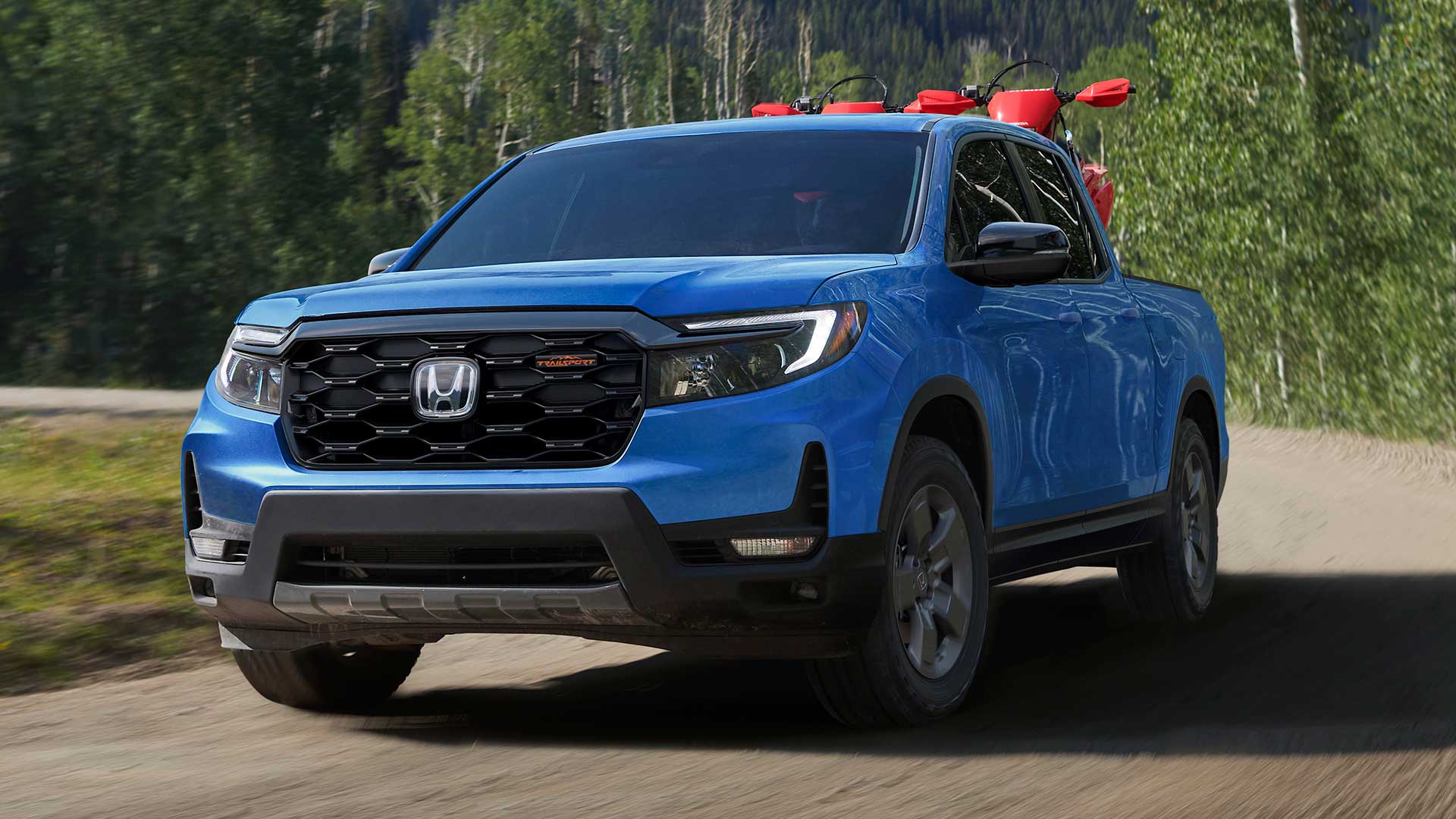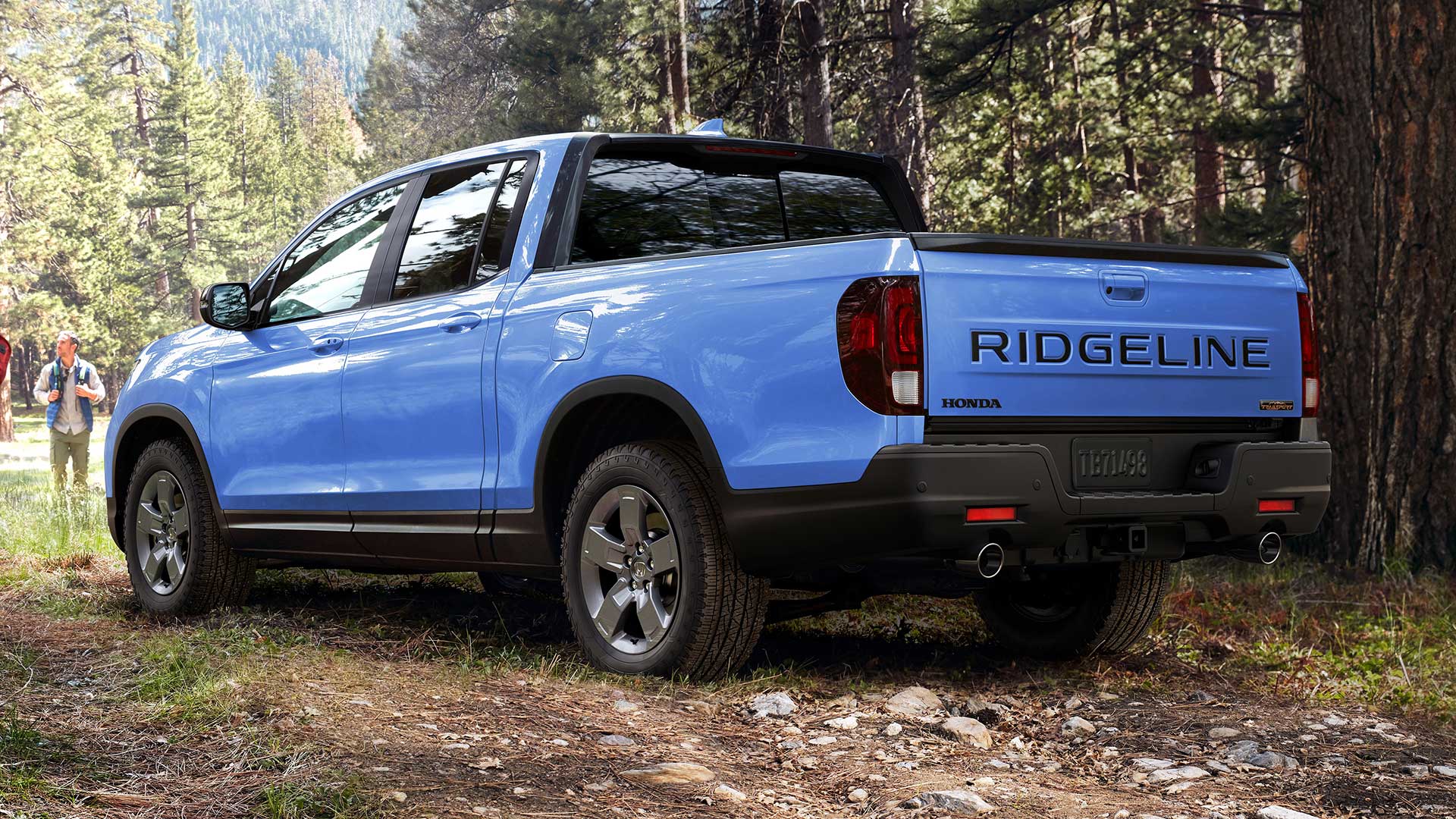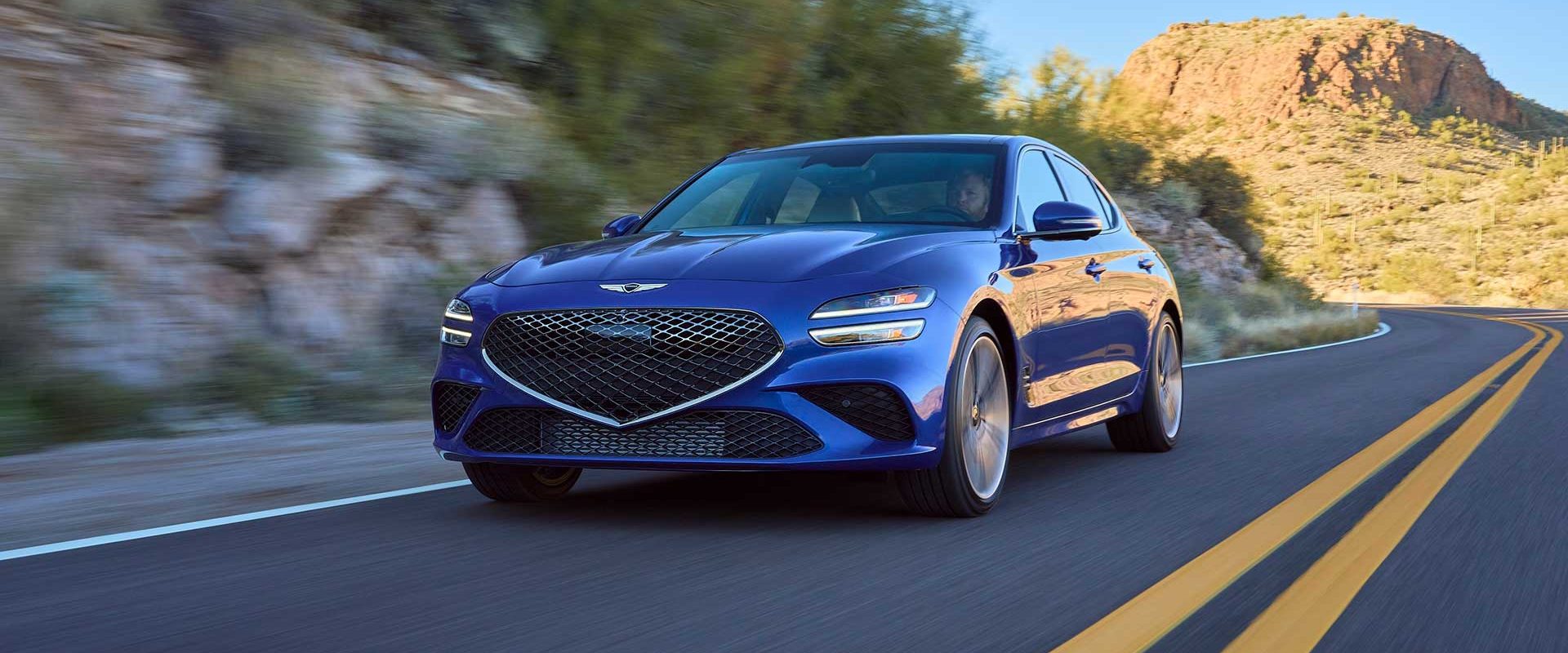2015 Alfa Romeo 4C
Over the years, predictions of Alfa Romeo’s immanent return to the US have been many. But actual cars for driving have been few. Well, that all changes now with this car, the Alfa Romeo 4C. And it’s fitting that the brand chose this back-to-basics fun-machine to re-launch a dealer network here in the states. After all, this car is all about the driving.
Yes, the 2015 Alfa Romeo 4C is not a car for everyone. But, if you’re the type that enjoys the straightforward, back-to-basics thrill ride of a sports car; then consider yourself lucky… your new ride just arrived.
Making things as light as possible is always a great sports car strategy, and this mid-engine monocoquester weighs in at only 2,465-pounds. Yes, that’s not as light as the European model, but trust us you won’t notice the additional 100-pounds or so added to meet U.S. crash standards.
Unfortunately, that minimalism takes its toll on the interior. There’s very little storage space or comfort to be found; and crawling in is not graceful for anyone on the high side of 6-feet or on the wrong side of 50. Foot well area is actually plentiful though, except for some slight intrusion on the left side; and the seats have a decent amount of travel. It’s the passenger that actually gets squeezed a bit more.
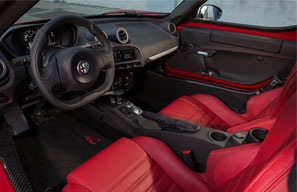 Seats feel like leather covered racing buckets with some extreme bolstering, and there’s just enough padding in them to drain the fuel tank.
Seats feel like leather covered racing buckets with some extreme bolstering, and there’s just enough padding in them to drain the fuel tank.
Burning up that fuel is a fun-size 1.7-liter I4 engine. Don’t let the small volume fool you. This little turbo cranks up 237-horsepower and 258 lb-ft. of torque with almost 22 psi of boost. Do you remember when 100-horsepower per liter was a big deal? It looks like those days are long gone.
Government Fuel Economy Ratings are 24-City, 34-Highway, and 28-Combined…which keeps the Energy Impact Score fairly good at 11.8-barrels of yearly oil use with CO2 emissions of 5.2-tons.
All 4Cs have a paddle shifted twin-clutch automatic transmission for gearing duties. In typical exotic car fashion, it’s not super smooth when tooling in auto mode and it seems in a hurry to get you into higher gears if you let it. But, get more aggressive and drive the car like it was meant to be driven and it responds beautifully.
Equally satisfying is the handling experience with is just pure joy, the way only mid-engine cars with close to 50/50 weight distribution can be. In a break from just about every car on the road, steering is fully manual with no power assist. While that will certainly have its detractors, if you’re buying this car to actually drive it, you won’t mind it at all.
 That certainly brings nostalgia to mind, but that’s just the beginning. There’s an upright 60’s driving position that has you looking directly down on the road. The engine is located right behind your head, with a new kind of direct injection; one that injects performance feel directly into your head. But as cool as it sounds, it can also get a little old after prolonged exposure.
That certainly brings nostalgia to mind, but that’s just the beginning. There’s an upright 60’s driving position that has you looking directly down on the road. The engine is located right behind your head, with a new kind of direct injection; one that injects performance feel directly into your head. But as cool as it sounds, it can also get a little old after prolonged exposure.
There’s a good, thick, flat bottom wheel for the hands; and there’s a real sensation of the road rushing up at you, even when cruising around town. You don’t have to be travelling at arrest worthy speeds to get a full sensory overload rush from this car.
Tires feel every groove in the pavement, and since there’s a direct link to your hands, so do you. You also get a sense that this car will bite you if you’re not judicious with throttle application. You really have to go back to 60s or 70s exotics to get a comparable driving experience.
Acceleration is much more in the modern era. There’s plenty of grip for launching; and a quick trip to 60 is possible in just over 4.0-seconds. Shifts occur in a nanosecond and hit hard, accompanied by a sound symphony of mechanical chaos directly behind you. ¼-mile times are in the 13.0-second range at 106 miles-per-hour. The brakes are full-on “beast mode”; laser straight, nice stiff pedal, and stops of just 99-feet from 60.
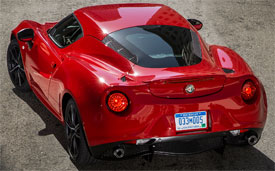 Equally adept at bringing a halt to things are the 4C’s beautiful, pure Italian lines. It looks like a baby Ferrari especially in this vibrant red. Spectacular from just about every angle, with the same basic mid-engine proportion layout that worked so well for the prancing horse for decades.
Equally adept at bringing a halt to things are the 4C’s beautiful, pure Italian lines. It looks like a baby Ferrari especially in this vibrant red. Spectacular from just about every angle, with the same basic mid-engine proportion layout that worked so well for the prancing horse for decades.
The 4C Launch Edition is all that’s available for the time being, and it’ll cost you $69,695; but once they’re gone a base 4C will start at $55,195.
That makes the 2015 Alfa Romeo 4C a small-scale exotic for a fraction of the price; truly a unique experience. It’s not a race car, and it’s not a poseur mobile. It’s a car designed with one thing in mind, driving!
Specifications
- Engine: 1.7 liter
- Horsepower: 237
- Torque: 258 lb-ft.
- 0-60 mph: 4.3 seconds
- 1/4 mile: 13.0 seconds @ 106 mph
- EPA: 24 mpg city/ 34 mpg highway
- Energy Impact: 11.8 barrels of oil/yr
- CO2 Emissions: 5.2 tons/yr
2024 Honda Ridgeline TrailSport
It Does Truck-Like Things Better Than Ever
Honda brought something truly unique to the pickup truck scene when their mid-size Ridgeline debuted for 2006. In 2017, it moved towards becoming a little more true truck-like, both in form and capability, now with yet another step in that direction for 2024. So, let’s see if the Ridgeline is really hitting its stride.
For 2024, it’s all about making this Honda Ridgeline better than ever. There are styling tweaks outside, along with tech and functional improvements inside, but the biggest news is the Ridgeline has now joined Honda’s TrailSport family of off-road inspired vehicles. This more-true-trucklike, second-gen Ridgeline been around since 2017, receiving periodic updates over the years; but joining the TrailSport family is the biggest leap yet.
Primarily, the TrailSport transformation includes General Grabber all-terrain tires, mounted on new Pewter Gray 18-inch wheels, steel underbody protection, and retuning the strut front, and multi-link rear suspension for added wheel articulation. And while we always appreciate the additional traction of off-road tires, the Ridgeline’s standard i-VTM4 all-wheel drive, with Intelligent Traction Management and snow, sand, and mud settings, was already quite capable of handling all but the most extreme off-roading, ground clearance of just 7.6 inches being it’s only real hinderance.
A 3.5-liter V6 remains under the hood as it has since the Ridgeline debuted for 2006; the current version outputs 280 horsepower and 262 lb-ft of torque, plenty enough muscle to handle its 5,000-lbs. towing capacity. A nine-speed automatic transmission with paddle shifters and bevy of push and pull buttons on the console replaced the six-speed automatic back in 2020.
In addition to adding TrailSport capability, a big focus for this update was making it more user-friendly inside, starting with the central touchscreen growing from 8 to 9 inches. It also gets faster processing speeds, menus have been simplified, and the native navigation system is improved with better graphics. It’s accompanied by a new digital instrument cluster, along with an upgraded center console with more storage space. Unique TrailSport touches include heavy duty floormats, leather-trimmed seats, orange stitching throughout the cabin, and orange ambient lighting.
The Ridgeline continues to offer things available nowhere else in the pickup truck market.
Exterior styling doesn’t exactly shout “macho big rig coming your way,” but the more vertical face and larger grille that arrived for 2021, along with this year’s added TrailSport elements, do continue to toughen up the Ridgeline’s image. The 5’4” bed remains highly functional with no large wheel well intrusions, multiple tie-downs points, lighting and even speakers. And of course, the Ridgeline continues to offer things available nowhere else in the pickup truck market, like the dual-action tailgate, and large, lockable, drainable, underbed storage. Not to mention being able to drive around in true car-like comfort, something we took full advantage of on our way to our Mason Dixon Dragway test track.
There was great grip off the line, with full power arriving smoothly but quickly, helping us to get to 60 in 7.0 seconds flat, a tenth quicker than the last Ridgeline we tested. That power delivery stayed fairly consistent the whole way down the track, barely interrupted by the nine-speed automatic’s smooth shifting. Our best quarter-mile run was 15.5 seconds at 90 mph.
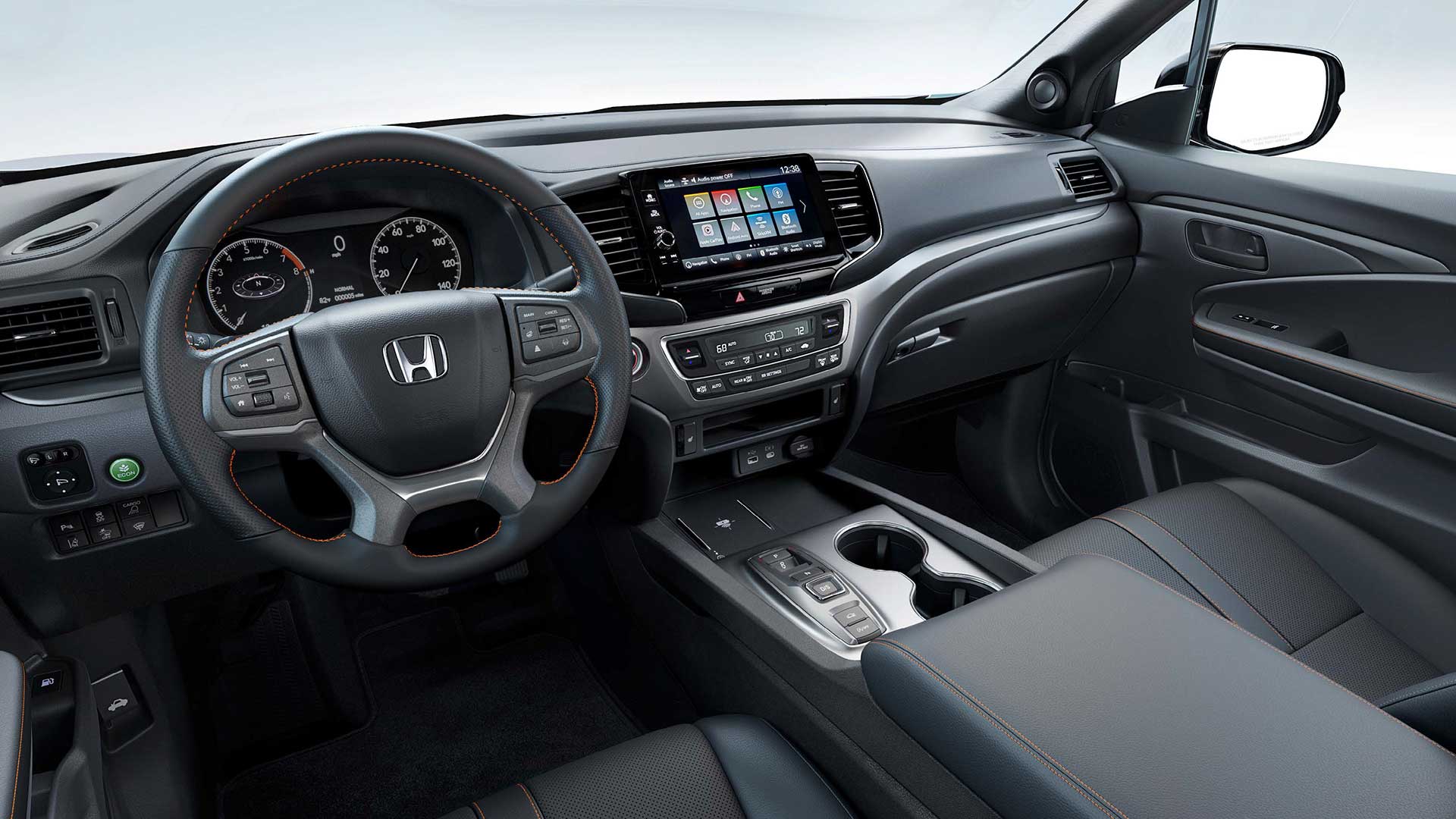
The revised suspension and knobbier tires didn’t really seem to add or detract from handling prowess, as it felt as solid, nimble, and car-like as it always has through our cone course. Perhaps a little less stiff than before, but good feedback, tight steering, and minimal body roll for a pickup, made for a very confidence inspiring experience. In our braking test, we stopped in a respectable average of 123 feet from 60, with only moderate amounts of nosedive and good feel through the pedal.
There is, however, a slight reduction in Government Fuel Economy Ratings with the all-terrain tires; 18-City, 23-Highway, and 20-Combined, our average, right on, at 20.4 mpg of Regular. That’s a slightly below average Energy Impact Score of 14.9 barrels of yearly oil use, with CO2 emissions of 7.4 tons.
TrailSport pricing falls in line just under the Ridgeline’s top Black Edition trim with a starting price of $46,375, about five grand over a base Ridgeline Sport.
So, whether you consider the Honda Ridgeline to be a “real” truck or not, this ruggedly smooth 2024 TrailSport does truck-like things better than ever. And we’re not just talking about the slight upgrade in off-road performance, we’re talking about a flexible bed to help you get chores done, and the ability to tow or haul with comfort and flexibility other trucks can only wish for. It’s why the Ridgeline brings more first-time buyers to Honda than any other vehicle, and why it continues to be a great choice in the growing midsize truck realm.
Specifications
- Engine: 3.5-liter V6
- Transmission: 9-speed automatic
- Horsepower: 280
- Torque: 262 lb-ft
- EPA: 18 City | 23 Highway | 20 Combined
- 0-60 mph: 7.0 seconds
- 1/4 Mile: 15.5 seconds at 90 mph
- 60-0 Braking (avg): 123 feet
- MW Fuel Economy: 20.4 mpg (Regular)
- Max Towing Capacity: 5,000-lbs
2024 Genesis G70
New Standard Engine For The G70 Means More Power And More Performance
It was 5 years ago, at a time when sedan sales were rapidly declining, that Genesis decided to unveil an all-new four-door, the G70. And just to make things more difficult, it was designed to compete directly against the best European compact sport sedans, which it did impressively well. So yes, the G70 is still hanging around; and what’s more, it’s gotten even better!
The Genesis G70 sedan has been on the road for half a decade now, and looks to have some real staying power, having outlasted its platform-mate, the Kia Stinger. But this 2024 Genesis G70 is not just surviving, but thriving, with a new standard powertrain, upgraded performance and an enhanced interior.
The standard engine in the G70 is now a 2.5-liter turbo I4 with 300 horsepower and 311 lb-ft of torque. That’s a 48-horsepower increase over last year’s 2.0-liter turbo-four. Genesis has also included a Brembo brake package as standard equipment. The 3.3-liter twin-turbo V6 remains available and carries over unchanged at 365 horsepower; both engines powering the rear wheels as standard, with all-wheel-drive optional.
The approach for the interior remains more of a sporty presentation instead of the outright luxury slant of larger Genesis sedans, and the main updates here include new touch-panel controls for climate and a frameless rear-view mirror. A reasonably priced Sport Prestige package adds leather seating, aluminum trim, a big sunroof and additional driver assistance features. Front seats are both sporty-feeling and comfortable, while things remain a little tight for adults in the rear seats.
No new sheet-metal for the outside, as that was freshened up for the ’22 model year; the design remains polished and smooth, void of garish details, but it does sport the new Genesis engraved emblem front and center above the grille.
Automatic shifts were very punchy, with a noticeable hit of power as each new gear was engaged.
We pointed that logo down our Mason Dixon Dragway test track to see what the new turbo-four engine is capable of. It felt plenty powerful off the line, even with a hint of turbo lag, and power delivery only became more aggressive from there. We hit 60 in 5.8 seconds, almost a half-second quicker than we saw with the 2.0-liter. That’s also with all-wheel-drive, which provided plenty of grip at takeoff, and good stability down the track, though spring track maintenance kept us from getting full quarter-mile times.
All G70s now work exclusively with a rev-matching eight-speed automatic with paddle shifters and intelligent drive modes; the six-speed manual transmission has gone away with the 2.0-liter. Automatic shifts were very punchy, with a noticeable hit of power as each new gear was engaged. Engine noise is pleasant but relatively muted, with just a hint of exhaust noise seeping into the cabin.
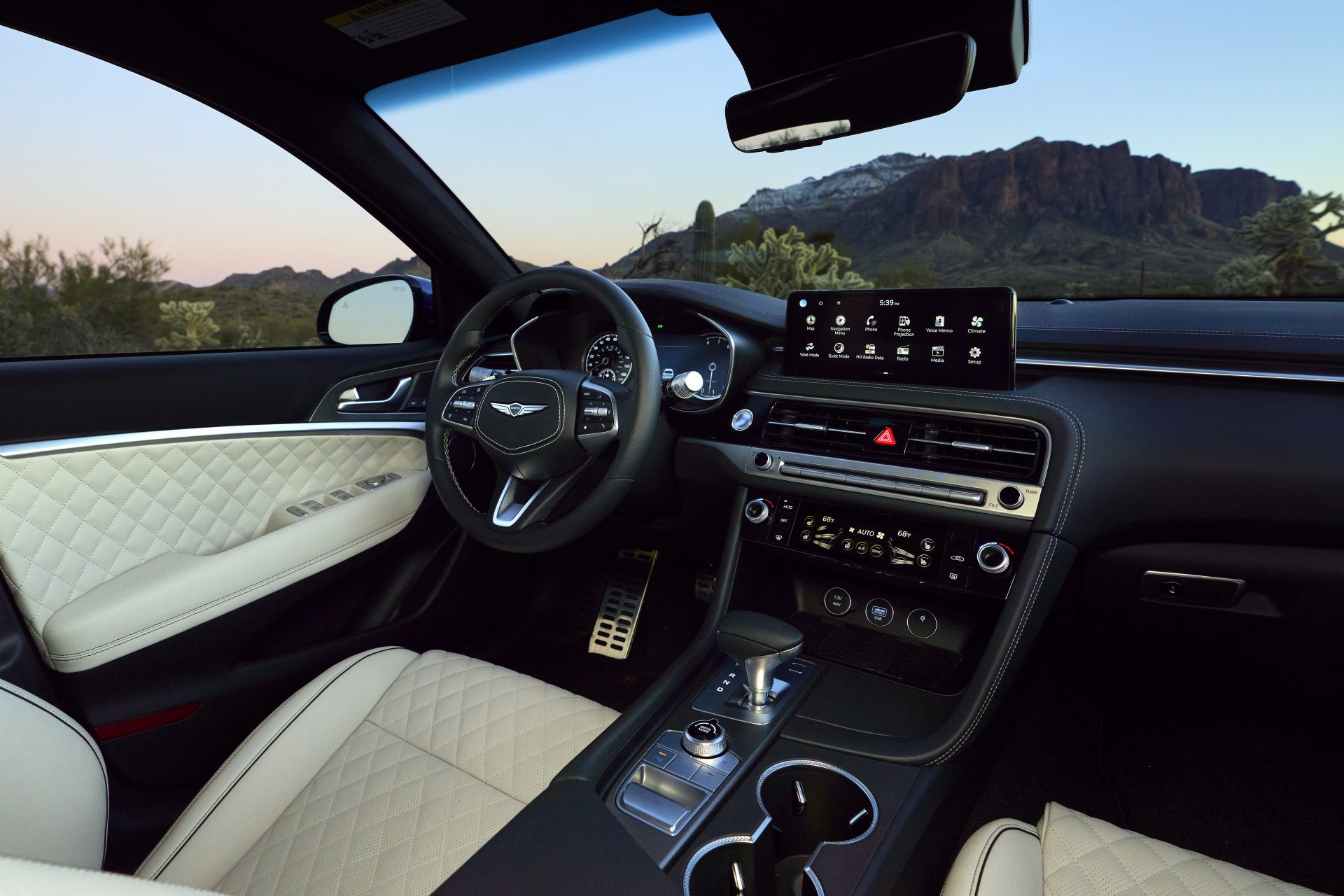
While the G70 can feel like a big sedan in everyday driving, here in our handling course, it felt tidy, nimble and quite comfortable working through the cones. We felt very connected to it, with great feedback through the chassis and steering wheel. Dynamic Torque Vectoring Control is in play to tighten up turn-ins and provide steadiness, and it worked great allowing us to be very aggressive without stability control systems stepping in, even when it began to show a little bit of understeer as we pushed the envelope.
As for everyday driving, Government Fuel Economy Ratings with the new four-cylinder and all-wheel-drive are 21-City, 29-Highway, and 24-Combined; we averaged a very good 27.8 mpg on Premium fuel. All for an average Energy Impact Score, using 12.4 barrels of oil annually with 6.2 tons of CO2 emissions.
The more powerful standard engine and interior upgrades add about two-grand to the G70’s new base price, which is now $42,750, $44,850 with all-wheel-drive; the twin-turbo V6 starts at $51,200.
These days, we’re just glad to see someone still making sporty 4-doors. So, when a brand puts the effort into making a good one even better, as Genesis has done with the 2024 G70, well that’s really a cause for celebration. The G70 may be a relative newcomer to the luxury sport sedan scene, but its comfort bang for the buck, along with its additional standard power and proven all-around performance, gives it the staying power it needs to succeed long term.
Specifications
As Tested
- Engine: 2.5-liter turbo I4
- Transmission: 8-speed auto
- Horsepower: 300
- Torque: 311 lb-ft
- EPA: 21 City | 29 Highway | 24 Combined
- 0-60 mph: 5.8 seconds
- 1/4 Mile: N/A
- 60-0 Braking: N/A
- MW Fuel Economy: 27.8 mpg (Premium)








